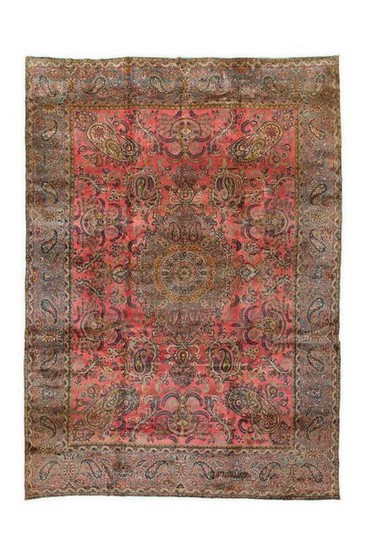Ravar Kirman 410 X 295 cm
Origin :Â South Persia
Size:Â 410 x 295 cm (Approximately 161.4 X 116.1 inch)
Age:Â 1st quarter of 20th century
Knots: 7 x 7= 49 knots per sq cm
Condition: Very good, elegant design ready to use.
Description of Design and History:
Kerman Lavar Rugs and antique Kerman Ravar Carpets refer to the same thing “ the prestigious carpet-weaving center known as Ravar/ Lavar. Ravar or Lavar is a small village located 80 miles north of Kerman. The rugs produced in Raver/ Lavar are often included in the general category of Kerman rugs, yet the reputation of this small town surpasses many larger cities. The village of Ravar/ Lavar has a long-standing reputation for producing some of the finest rugs in the Kerman region.¨Lavar is a trade term and linguistic permutation that is used in the west to describe rugs produced in the village of Ravar. Over the years, other regional towns adapted Ravar™s elegant floral style and impeccable construction techniques. Kerman Lavar rugs are occasionally produced in the nearby city of Rafsanjan and workshops, such as Atiyeh, that specialized in producing later adaptations of Persian Lavar Kerman rugs.
According to explanations developed by historians, Ravar/ Lavar rose to prominence in the 1800â„¢s when artisan craftspeople fled the city of Kerman, which was under attack. In the village of Ravar/ Lavar, these carpet weavers developed their own style that incorporated voluminous floral patterns woven in an impressive array of colors. Kerman Lavar rugs also include detailed pictorials rendered in a style similar to the pictorial scenes produced in Qum and Isfahan. Many early Kerman Lavar rugs feature kaleidoscopic floral patterns and curvilinear vinescrolls decorated with a variety of vibrant and subdued colors. In the 20th century, regional designs shifted to reflect a European composition, including saturated colors and a rich monochromatic field. Lavar Kerman rugs feature supremely detailed patterns, innovative colors and discontinuous borders with elements that invade neighboring areas. The impeccable craftsmanship, tightly placed knots and exceptionally diverse range of colors set Kerman Lavar rugs apart from those created in Persiaâ„¢s other great carpet-producing cities.¨All natural dyes are paramount for the carpet to have more than just decorative value. Beyond that, various dyers had varying levels of skill and invested different lengths of time in dyeing the yarns. The Å“quality of color“its radiance and level of nuance within each color“is centrally important. Certain rare colors such as Tyrian purple, saffron yellow, cochineal rose and greens add to the carpetâ„¢s value
Condition Report: The absence of a condition report does not imply that the lot is in perfect condition. Please carefully read our terms of sale, shipping pick up & payment information. We are happy and willing to answer questions about any of our lots as well as to send additional images. It is the responsibility of the bidder to pose any questions BEFORE bidding. Please email us for a shipping quote if needed. All sales are final.
View it on
Estimate
Time, Location
Auction House
Origin :Â South Persia
Size:Â 410 x 295 cm (Approximately 161.4 X 116.1 inch)
Age:Â 1st quarter of 20th century
Knots: 7 x 7= 49 knots per sq cm
Condition: Very good, elegant design ready to use.
Description of Design and History:
Kerman Lavar Rugs and antique Kerman Ravar Carpets refer to the same thing “ the prestigious carpet-weaving center known as Ravar/ Lavar. Ravar or Lavar is a small village located 80 miles north of Kerman. The rugs produced in Raver/ Lavar are often included in the general category of Kerman rugs, yet the reputation of this small town surpasses many larger cities. The village of Ravar/ Lavar has a long-standing reputation for producing some of the finest rugs in the Kerman region.¨Lavar is a trade term and linguistic permutation that is used in the west to describe rugs produced in the village of Ravar. Over the years, other regional towns adapted Ravar™s elegant floral style and impeccable construction techniques. Kerman Lavar rugs are occasionally produced in the nearby city of Rafsanjan and workshops, such as Atiyeh, that specialized in producing later adaptations of Persian Lavar Kerman rugs.
According to explanations developed by historians, Ravar/ Lavar rose to prominence in the 1800â„¢s when artisan craftspeople fled the city of Kerman, which was under attack. In the village of Ravar/ Lavar, these carpet weavers developed their own style that incorporated voluminous floral patterns woven in an impressive array of colors. Kerman Lavar rugs also include detailed pictorials rendered in a style similar to the pictorial scenes produced in Qum and Isfahan. Many early Kerman Lavar rugs feature kaleidoscopic floral patterns and curvilinear vinescrolls decorated with a variety of vibrant and subdued colors. In the 20th century, regional designs shifted to reflect a European composition, including saturated colors and a rich monochromatic field. Lavar Kerman rugs feature supremely detailed patterns, innovative colors and discontinuous borders with elements that invade neighboring areas. The impeccable craftsmanship, tightly placed knots and exceptionally diverse range of colors set Kerman Lavar rugs apart from those created in Persiaâ„¢s other great carpet-producing cities.¨All natural dyes are paramount for the carpet to have more than just decorative value. Beyond that, various dyers had varying levels of skill and invested different lengths of time in dyeing the yarns. The Å“quality of color“its radiance and level of nuance within each color“is centrally important. Certain rare colors such as Tyrian purple, saffron yellow, cochineal rose and greens add to the carpetâ„¢s value
Condition Report: The absence of a condition report does not imply that the lot is in perfect condition. Please carefully read our terms of sale, shipping pick up & payment information. We are happy and willing to answer questions about any of our lots as well as to send additional images. It is the responsibility of the bidder to pose any questions BEFORE bidding. Please email us for a shipping quote if needed. All sales are final.



